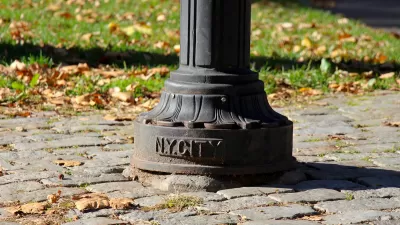A 1980 law protecting pedestrians from falling debris has spawned a labyrinth of sidewalk sheds: the covered walkways that often support scaffolding. Many of these "temporary" structures linger for years.

Construction and repair work brings with it a collection of temporary structures. Too often, those sheds, scaffolds, barriers, and portable toilets can become semi-permanent fixtures that mar the beauty of a street or facade for years on end. Aaron Elstein documents one such case: the New York City sidewalk shed.
A 1980 law requires building owners to protect pedestrians from falling masonry, but good intentions have led to unexpected side effects. Elstein writes, "[Landlord Muhammad] Shahid may infuriate people who live near his property, but he's one of many landlords who have concluded it's cheaper to keep up a shed—and pay fines for violations—than it is to fix a building."
The maze of sheds girdling the city's walkways are an unsightly nuisance to residents and business owners. From the article: "The chief purpose of this particular shed, on a handsome block in the Mount Morris Park Historic District, seems to be to collect garbage and provide shelter to the loiterers who lurk underneath. Repairs at the building it surrounds move at a glacial pace."
The scale of New York's shed problem is troubling given its status as the nation's most walkable metropolis. "There are now nearly 9,000 sheds entombing city streets, according to the Department of Buildings, up from about 3,500 in 2003. That's 190 miles worth of sheds, or 1 million linear feet."
FULL STORY: The law that created the billion-dollar scaffold industry has turned city sidewalks into an obstacle course

Alabama: Trump Terminates Settlements for Black Communities Harmed By Raw Sewage
Trump deemed the landmark civil rights agreement “illegal DEI and environmental justice policy.”

Planetizen Federal Action Tracker
A weekly monitor of how Trump’s orders and actions are impacting planners and planning in America.

The 120 Year Old Tiny Home Villages That Sheltered San Francisco’s Earthquake Refugees
More than a century ago, San Francisco mobilized to house thousands of residents displaced by the 1906 earthquake. Could their strategy offer a model for the present?

In Both Crashes and Crime, Public Transportation is Far Safer than Driving
Contrary to popular assumptions, public transportation has far lower crash and crime rates than automobile travel. For safer communities, improve and encourage transit travel.

Report: Zoning Reforms Should Complement Nashville’s Ambitious Transit Plan
Without reform, restrictive zoning codes will limit the impact of the city’s planned transit expansion and could exclude some of the residents who depend on transit the most.

Judge Orders Release of Frozen IRA, IIJA Funding
The decision is a victory for environmental groups who charged that freezing funds for critical infrastructure and disaster response programs caused “real and irreparable harm” to communities.
Urban Design for Planners 1: Software Tools
This six-course series explores essential urban design concepts using open source software and equips planners with the tools they need to participate fully in the urban design process.
Planning for Universal Design
Learn the tools for implementing Universal Design in planning regulations.
Clanton & Associates, Inc.
Jessamine County Fiscal Court
Institute for Housing and Urban Development Studies (IHS)
City of Grandview
Harvard GSD Executive Education
Toledo-Lucas County Plan Commissions
Salt Lake City
NYU Wagner Graduate School of Public Service




























